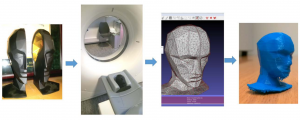The DAT253 course covers 3D printing, game engine programming (Unity3D), Virtual Reality, and real-time ray tracing. It is an advantage, but not necessity, that the student has already taken an introductory course in computer graphics and is comfortable with mathematics. The student will in the course:
- Perform a CT scan of an object
- Create software in Unity3D for rendering the scan and extracting its surface geometry
- Create a Virtual Reality solution for manipulating the geometry
- 3D print the result
- Create a photorealistic ray tracer in Unity
Results from 2017 course:

From left to right: A physical object to be scanned, the CT scanning, the surface model and the 3D printout
Above: Filmclip showing student work of interactive ray-tracer
Introduction
The course covers central topics and new developments in computer graphics such as 3D printing, game engine programming (Unity3D), Virtual Reality, and real-time ray tracing.
The course consists of two parts. In the first part the students gets a hands-on introduction to geometry representation and geometry processing through the practical task of digitizing and reproducing a physical object. The second part complements this by teaching how to accurately render geometry with photorealistic ray tracing.
Learning outcome
Knowledge
The student will learn the basics of:
- Data structures for manipulating and rendering surfaces
- Representing volumetric data
- Transforming from implicit to parametric surface representation using the marching tetrahedra algorithm
- Programming for Virtual Reality and interaction with 3D objects
- Light transport and the principles of ray tracing
Skills
The students will be able to:
- Reproduce scanned physical objects
- Prepare a surface mesh for 3D printing and printing it
- Create Virtual Reality applications
- Implement a real-time ray tracer in GPU shading language
- Perform graphics programming in the Unity game engine
Competence
- The competence gained in this course will prepare the student for the emerging field of digital modelling and fabrication.
- The student will be able to use the Unity game engine for designing tailored and advanced computer graphics solutions, including Virtual Reality solutions.
- The student will get an introduction to ray tracing, the rendering technology behind animation movies and motion pictures special effects
Study methods
Lectures, practical and theoretical exercises and student projects with presentation.
Prerequisites
General knowledge in mathematics and computer science.
It is an advantage if the student has already taken an introductory course in computer graphics.
Mandatory assignments
A number of mandatory assignments in the form of written reports and oral presentations.
The assignments must be submitted within set deadlines and must be approved before examination can take place.
Approved assignments are valid for the examination semester and 2 following semesters.
Methods of assessment
Oral exam.
Grading scale is A-F where F is fail
Literature list
Lecture slides, exercises and research articles.
Course coordinator
Daniel Patel